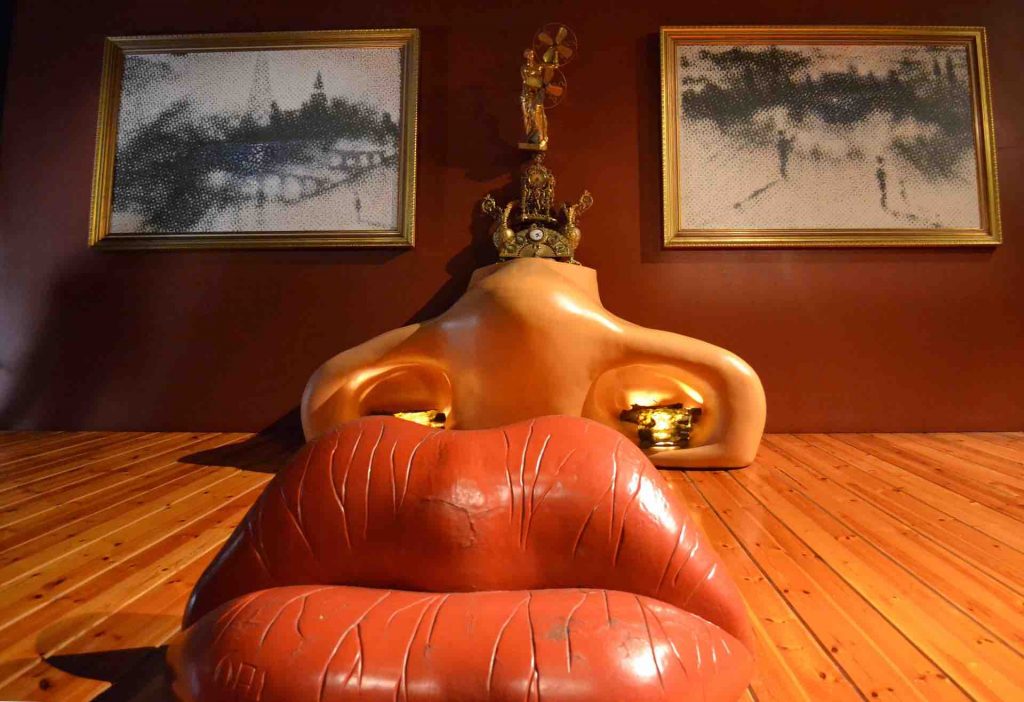Here are the basic Facts on Salvador Dali – for lovers of this Spanish-Catalan surrealist painter, with his Velazquez moustache and wildly eccentric behaviour.
In spite of being a flamboyant exhibitionist with numerous peculiar traits, he was – undoubtedly – a talented and hard worker.
During his lifetime, he produced more than 1,500 paintings – as well as illustrations for books and lithographs.
His artistic work was cerrtainly not confined to painting alone …
He created artchitectural and literary works, sculptures, plus scenery and sets for theatrical productions.
He collaborated on works with various photographers and fashion designers – including Elsa Schiaparelli and Christian Dior.
And, in the film world, he was responsible – with Buñuel – for the short film “Un chien andalou”, and for the short Disney cartoon “Destino”.
Nowadays, the largest collection of his work can be enjoyed in Spain at the Dali Theatre and Museum, Figueres, Catalonia.
But … let’s take a look at some of those Facts on Salvador Dali …
Early years 1904-1929
- 1904 – born 11 May, Salvador Felipe Jacinto Dalí Domènech – in Figueres, Catalonia, Spain – to a middle-class family, his father a notary.
- 1908 – Dalí’s sister – Ana María – is born.
- 1916 – Discovers modern art.
- 1921 – Mother dies of cancer.
- 1922 – Goes to Madrid and studies at San Francisco School of Fine Arts. Already an eccentric dresser, complete with moustache, he experiments with Cubism and Dada. Becomes a close friend of poet/playwright Federico García Lorca and film-maker Louis Buñuel.
- 1926 – Expelled from San Francisco School of Fine Arts. First visit to Paris, where he meets with Picasso and Miró.
Middle years 1929-1941
- 1929 – Collaborates with Louis Buñuel on short film “Un Chien Andalou”. Meets future wife – Gala – a Russian immigrant, 11 years his senior. Officially joins the Surrealist Group in Montparnasse, Paris.
- 1931 – Produces “The Persistance of Memory” – his most famous work. The soft watches suggest Einstein’s theory that time is relative and not fixed.
- 1934 – Salvador Dalí and Gala marry in a civil ceremony. Expelled from Surrealist Group, partly because of political beliefs.
- 1936 – Takes part in London International Surrealist Exhibition, delivering his lecture wearing a deep-sea diving suit. Paints “Autumn Cannibalism” and “Soft Construction with Boiled Beans: Premonition of Civil War”.
- 1938 – Meets Sigmund Freud in London. Draws several portraits of him.
- 1940 – World War II starts in Europe and Dalí and Gala move to United States – where they remain for 8 years.

Later years 1941-1989
- 1942 – His first autobiography is published – “The Secret Life of Salvador Dalí”.
- 1948 – Returns to Catalonia, Spain and is much-criticised by other artists for living under the Franco régime.
- 1958 – Remarries Gala in a Catholic religious ceremony.
- 1950-60 – Artistic works include “Temptation of Saint Anthony”, “Christ of St John on the Cross”, “Assumpta Corpusculana Lapislazulina”, “Sacrament of the Last Supper”, “Discovery of American by Christopher Columbus”.
- 1960-74 – Works on the Dalí Theatre and Museum in Figueres.
- 1963 – His “Portrait of My Dead Brother” anticipates Pop Art.
- 1964 – Awarded the Grand Cross of Isabella the Catholic.
- 1969 – Designs the Chupa Chups (a Spanish lolly-pop) logo.
- 1978 – Exhibits first hyper-stereoscopic painting: “Dalí Lifting the Skin of the Mediterranean Sea to Show Gala the Birth of Venus”.
- 1982 – King Juan Carlos of Spain conferrs him with the title of “Marquís de Pubol” – he lives at Pubol Castle. Gala dies on 10 June and Dalí loses will to live.
- 1983 – Dalí paints his last painting: “The Swallowtail”.
- 1984 – Fire in Pubol Castle. Salvador Dalí returns to Figueres and lives in Theatre-Museum during his final years.
- 1989 – Dies of heart failure – aged 84 – and is buried in crypt of Theatre-Museum at Figueres. Leaves his entire fortune and works to Spanish state.
Famous paintings
The painter had an older brother who died 9 months before Salvador Dali’s own birth, and his parents treated him very much as a reincarnation of the first, dressing him in the dead brother’s clothes, etc.
This may well have helped form certain aspects of the artist’s character which reflected so much in his works …
His obsession with decay and putrification …his dual personality … his very developed inner world, leading to his Paranoic Critical method – a way of perceiving reality.
In his very early years he experimented with Cubism, was later especially noted for his Surrealism and, from the 1950’s onwards also experimented with bulletist works, holography and developed principles of Nuclear Mysticism.

